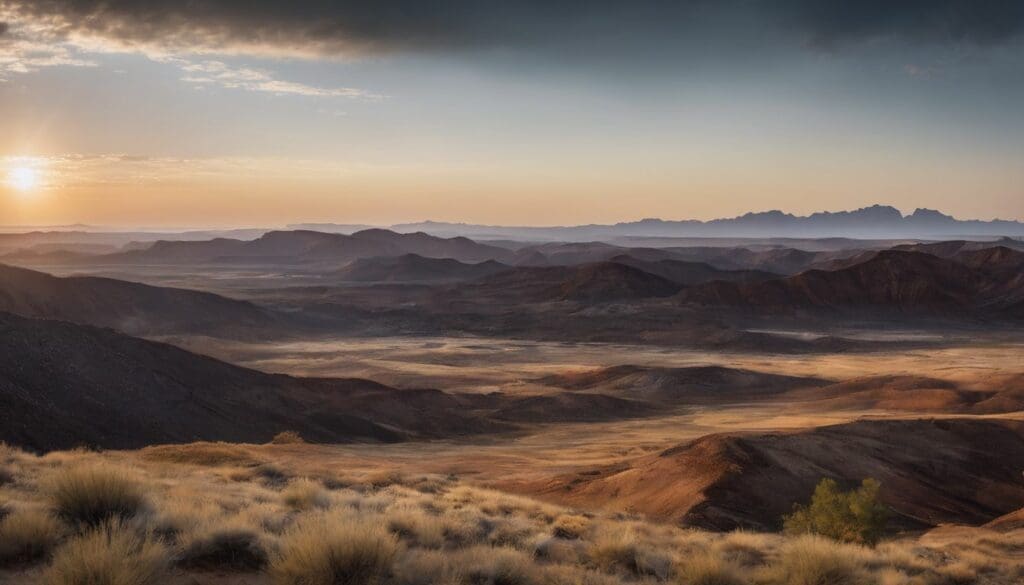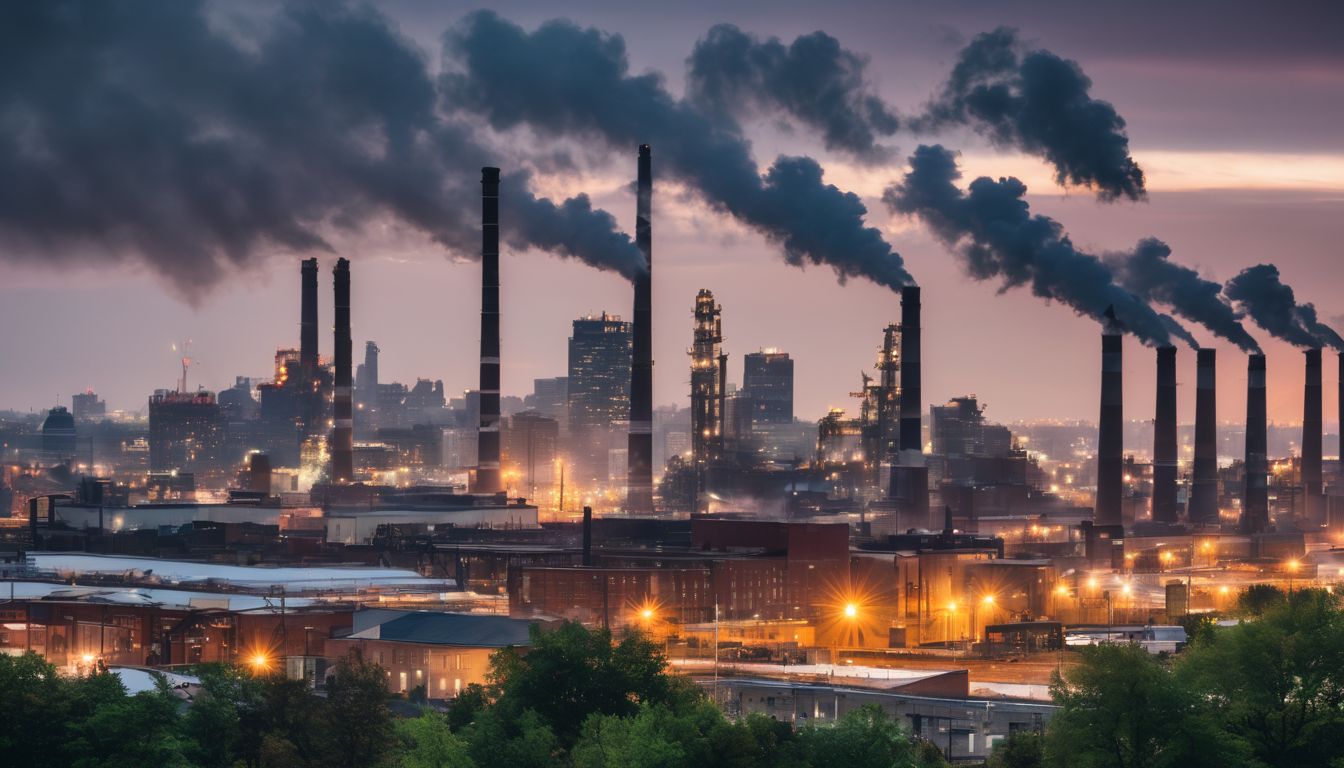Many of us worry about the animals and plants disappearing from our world. It’s shocking that up to one million species are at risk of extinction due to human activities. In this article, we’ll explore how global warming is speeding up biodiversity loss and what we can do to help.
Together, we can make a change!
Key Takeaways
- Biodiversity encompasses all life forms, with each species and ecosystem playing a unique role in maintaining natural balance; it’s essential for our own survival as it provides clean air, water, food and medicines.
- Human activities are a primary cause of biodiversity loss, including habitat destruction, pollution and climate change; these lead to the extinction of species and degradation of ecosystems.
- Global warming affects weather patterns, causes sea level rise and impacts marine life; this has dire consequences for human health through increased natural disasters and potential threats to food security.
- Nature – based solutions such as reforestation and sustainable agriculture can help mitigate climate change while conserving biodiversity; they involve planting trees, protecting habitats and promoting green urban spaces.
- Individuals can contribute to protecting biodiversity by reducing their carbon footprint, supporting conservation projects and participating in initiatives like Generation Hope that empower youth action on environmental issues.
Understanding Biodiversity Loss
Biodiversity is the variety of life on Earth, including all its different species and ecosystems. It’s essential for maintaining the balance of natural systems and provides numerous benefits to humans, such as clean air and water, food sources, and medicines.
Measuring biodiversity involves looking at the number of different species in an area as well as their genetic diversity. The main drivers of biodiversity loss include habitat destruction, pollution, overexploitation of resources, and climate change.
What is biodiversity?
Biodiversity encompasses the variety of life on Earth, from the smallest microorganisms to the vast rainforests and ocean depths. It includes every plant, animal, fungus, and microbe that make up the natural world.
Each species plays a unique role in their ecosystem, contributing to processes like pollination, decomposition, water purification, and climate regulation through carbon and nitrogen cycles.
Our planet’s biological diversity is akin to a colossal web where each thread is vital for its overall strength and resilience. As humans rely on healthy ecosystems for clean air, fresh water, food supply, and even medicines derived from plants and animals – biodiversity directly impacts our lives in countless ways.
Protecting this rich tapestry of life ensures that we maintain ecological balance necessary for our survival and that of future generations.
Importance of biodiversity
Biodiversity plays a crucial role in sustaining the balance of ecosystems, providing essential resources for humans and wildlife alike. It supports the pollination of crops, regulates climate patterns, and contributes to the overall resilience of natural systems.
Furthermore, biodiversity aids in maintaining genetic diversity within species, which is vital for adaptation to changing environmental conditions and mitigating potential extinction risks.
The preservation of biodiversity is fundamental in safeguarding our planet’s future by upholding ecosystem stability, supporting food security, and sustaining natural resources for current and future generations.
Conserving diverse habitats rich in plant and animal species is paramount in ensuring the continued provision of ecosystem services essential for human survival as well as protecting countless other life forms.
Measuring biodiversity
To understand the health of our ecosystems, we must measure biodiversity. Scientists use various methods such as species richness, genetic diversity, and ecosystem diversity to assess the variety and abundance of living organisms in a particular area.
This involves conducting surveys, collecting samples, and analysing data to determine the overall biodiversity and identify any changes over time. By measuring biodiversity, we can monitor the impact of human activities on natural habitats and make informed decisions to protect and conserve our planet’s rich biological resources.
Scale and drivers of biodiversity loss
Biodiversity loss occurs on a global scale, impacting terrestrial and marine ecosystems alike. Human activities such as deforestation, overfishing, pollution, and urbanisation are the primary drivers of this loss.
These activities disrupt habitats, leading to species extinction and ecosystem degradation. It’s crucial to address these drivers through conservation efforts and sustainable practices to protect our planet’s rich biodiversity for future generations.
Moving on to the next section about how climate change affects biodiversity..
How Climate Change Affects Biodiversity
Climate change leads to disruptions in weather patterns, rising sea levels, and negative impacts on marine life and human health. To learn more about the interconnectedness of climate change and biodiversity loss, keep reading!
Impact on weather patterns and natural disasters
Climate change significantly impacts weather patterns and natural disasters. Rising global temperatures intensify extreme weather events such as hurricanes, cyclones, and heatwaves.
Shifts in precipitation patterns result in more prolonged droughts and heavier rainfall, leading to floods and landslides. Melting ice caps contribute to sea-level rise, increasing the risk of coastal flooding.
The increased frequency and severity of these natural disasters pose a threat to ecosystems, wildlife habitats, human settlements, and agricultural productivity.
Sea level rise
Sea level rise is a result of global warming, where melting ice sheets and glaciers contribute to the increase in sea levels. As temperatures rise, so does the volume of seawater due to thermal expansion.
Coastal areas face immense threats from this phenomenon, including flooding, erosion, and salinization of freshwater sources. The biodiversity-rich ecosystems located in these zones are at risk of being submerged or altered, impacting marine life and dependent communities.
The implications of sea level rise extend beyond coastal regions; it also affects weather patterns and exacerbates natural disasters such as hurricanes and storm surges. Furthermore, rising seas threaten critical habitats like mangroves and coral reefs that serve as nurseries for numerous marine species.
Effects on marine life
The increase in ocean temperatures and acidity levels due to global warming significantly impacts marine life. Rising sea surface temperatures can lead to coral bleaching, affecting the delicate balance of marine ecosystems.
Ocean acidification affects the ability of shells and skeletons of marine animals to form, threatening species like oysters, clams, and corals. Additionally, changes in water temperature disrupt the distribution and behavior of fish species, affecting both their natural habitats and food sources.
Marine biodiversity is now facing unprecedented challenges resulting from climate change. Shifts in ocean conditions harm the intricate web of life that relies on healthy marine ecosystems for survival.
Consequences for human health and crops
The effects of climate change on marine life have severe implications for human health and crops. Rising sea levels can lead to saltwater intrusion, contaminating freshwater sources crucial for agriculture and drinking water.
This could reduce crop yields and affect the availability of safe drinking water, risking food security and public health. Additionally, extreme weather events such as hurricanes and storms become more frequent due to climate change, posing a direct threat to both human lives and agricultural infrastructure.
Furthermore, changes in temperature and precipitation patterns can alter the geographic range of disease-carrying vectors like mosquitoes, leading to an increased risk of diseases such as malaria or dengue fever.
Interconnectedness of Climate Change and Biodiversity Loss
The relationship between climate change and biodiversity loss is deeply interconnected. Biodiversity plays a crucial role in mitigating climate change through nature-based solutions, such as planting trees, while climate change has significant impacts on the health and diversity of ecosystems.
The role of biodiversity in mitigating climate change
Biodiversity plays a crucial role in mitigating climate change by maintaining healthy ecosystems, which act as natural carbon sinks. Diverse plant and animal species help regulate the Earth’s atmosphere and stabilise the climate by absorbing and storing carbon dioxide.
Additionally, diverse ecosystems enhance resilience to environmental changes, such as extreme weather events and rising temperatures, thereby contributing to overall climate stability.
Preserving biodiversity is essential for reducing greenhouse gas emissions through nature-based solutions like reforestation, habitat conservation, and sustainable land management.
Nature-based solutions
After understanding the role of biodiversity in mitigating climate change, it is imperative to explore nature-based solutions and their impact on the environment. These solutions offer sustainable and effective ways to address the challenges posed by climate change and biodiversity loss.
- Reforestation: Planting trees helps in restoring ecosystems, absorbing carbon dioxide, and providing habitats for various species.
- Habitat restoration: Rehabilitating degraded habitats supports biodiversity, improves water quality, and enhances natural resilience to climate impacts.
- Wetland conservation: Preserving wetlands aids in flood control, filtering pollutants from water, and providing critical habitat for diverse plant and animal species.
- Sustainable agriculture practices: Implementing agroforestry, crop diversification, and organic farming reduces greenhouse gas emissions and protects soil health.
- Urban green spaces: Development of parks, green roofs, and community gardens contributes to urban biodiversity conservation while mitigating heat island effects.
- Marine protected areas: Establishing marine reserves safeguards marine ecosystems from overfishing, pollution, and habitat destruction.
- Coral reef preservation: Protecting coral reefs through sustainable fishing practices and reducing ocean pollution fosters healthy marine ecosystems.
- Ecosystem-based adaptation: Utilising natural systems such as mangroves for coastal protection against storm surges and sea-level rise.
Planting trees and other solutions
- Reforestation: Planting trees helps restore habitats and sequester carbon, mitigating climate change and supporting diverse ecosystems.
- Agroforestry: Integrate trees with agricultural practices to enhance soil health, biodiversity, and crop resilience whilst reducing carbon emissions.
- Urban forestry: Creating green spaces in cities through tree planting promotes cleaner air, reduces urban heat islands, and provides habitats for wildlife.
- Mangrove restoration: Protect coastal ecosystems by replanting mangroves, which serve as carbon sinks, stabilise shorelines, and support marine life.
- Community tree planting projects: Engage local communities in tree planting initiatives to foster environmental stewardship and build resilient ecosystems.
Taking Action to Protect Biodiversity
Individuals can take action to protect biodiversity by reducing their carbon footprint, supporting wildlife conservation efforts, and getting involved in initiatives like Generation Hope to make a positive impact on the environment.
Read on to learn more about how you can help protect biodiversity and combat global warming.
Individual actions to protect nature
- Reduce your carbon footprint by walking, cycling, or using public transport instead of driving.
- Support wildlife conservation efforts by volunteering at local nature reserves or donating to organisations working to protect endangered species.
- Plant native trees and plants in your community to create habitats for local wildlife and absorb carbon dioxide from the atmosphere.
- Educate others about the importance of biodiversity and climate change by sharing information on social media and participating in awareness campaigns.
- Advocate for sustainable practices in your community, such as promoting recycling and reducing plastic use to minimise environmental impact.
Generation Hope initiative
Individual actions to protect nature can have a significant impact on biodiversity and climate change. In addition to individual efforts, the Generation Hope initiative empowers and mobilises young people worldwide to take action in addressing environmental challenges.
This initiative aims to inspire the next generation of leaders by providing opportunities for education, advocacy, and practical conservation efforts. With the involvement of motivated individuals through this programme, there is hope for positive change in addressing the pressing issues of biodiversity loss and global warming.
The Generation Hope initiative encourages collaborative projects that foster sustainable practices, promote resilience to climate change impacts, and contribute towards preserving and restoring biodiversity.
Conclusion
In conclusion, protecting biodiversity is crucial for mitigating the effects of global warming. Individual actions, such as reducing energy consumption and supporting conservation efforts, play a vital role in reversing biodiversity loss.
The interconnection between climate change and species loss requires urgent attention and collaborative solutions at a global scale. It is imperative to act now to preserve our planet’s rich and diverse ecosystems for future generations.
FAQs
1. What is the link between biodiversity loss and global warming?
Biodiversity loss and global warming are connected because rising temperatures from climate crisis can lead to species loss and extinctions.
2. How does global warming affect the carbon cycle?
Global warming disrupts the carbon cycle by increasing atmospheric temperature, which can release more carbon into the air from natural sources.
3. Can stopping biodiversity loss help fight against climate change?
Yes, protecting diverse species helps maintain a balanced carbon cycle, which is crucial in fighting against global warming.
4. What actions can we take to reduce global warming and prevent further biodiversity loss?
To combat these issues, we need to decrease greenhouse gas emissions, protect habitats, and promote sustainable practices that support both biodiversity conservation and climate health.





